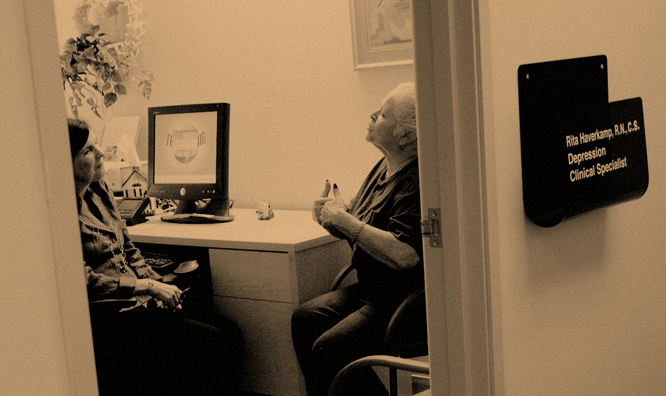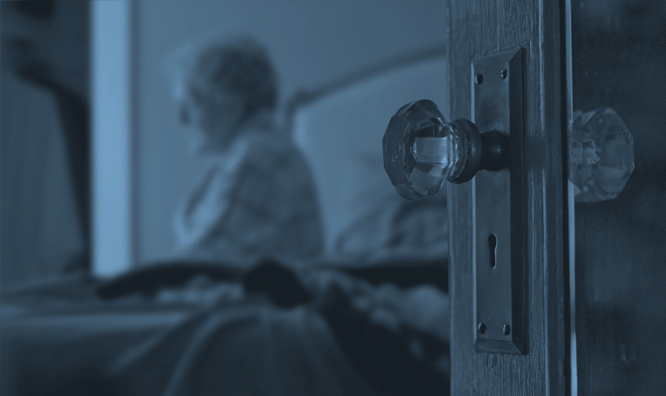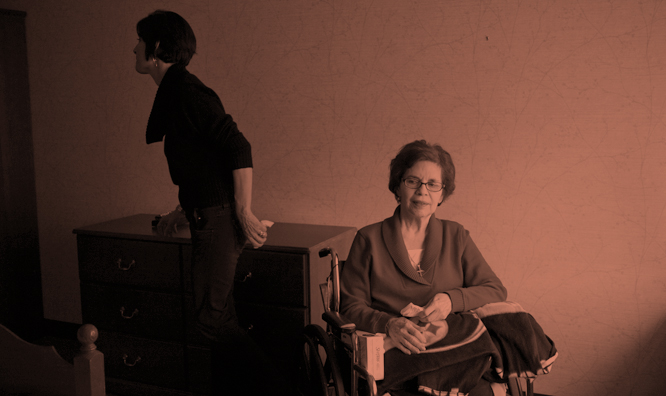MENTAL HEALTH AND THE OLDER ADULT
 Of the 40 million Americans age 65 and over, about 7.5 million have a
mental health disorder (such as depression, anxiety disorder, bipolar
disorder, or schizophrenia). This number is expected to grow as the
number of older people increases. Many older adults with mental
illness suffer needlessly. They may not have been diagnosed or are
receiving inadequate or, worse, no treatment. This can change, but it
will require sustained efforts on the part of health care providers;
older adults, their families and caregivers; policy makers; academic
institutions; and funders.
Of the 40 million Americans age 65 and over, about 7.5 million have a
mental health disorder (such as depression, anxiety disorder, bipolar
disorder, or schizophrenia). This number is expected to grow as the
number of older people increases. Many older adults with mental
illness suffer needlessly. They may not have been diagnosed or are
receiving inadequate or, worse, no treatment. This can change, but it
will require sustained efforts on the part of health care providers;
older adults, their families and caregivers; policy makers; academic
institutions; and funders.
Every person with a mental health condition has a unique story. In this Annual Report we share just a few stories to demonstrate how effective assessment and treatment can change people’s lives. Programs funded by the Hartford Foundation over the past 30 years focused on mental health are improving the lives of older adults by changing clinical practice, education, research, and health policy.
Introduction
“It is well known that the world population is aging,” says Dilip V. Jeste, MD, Director of the Hartford Center of Excellence in Geriatric Psychiatry, and Estelle and Edgar Levi Chair in Aging, University of California, San Diego. “What is not well known is the fact that the numbers of older people with mental illness will increase disproportionately faster than those of older adults in the general population.” By 2030 the number of Americans over age 65 with psychiatric disorders is estimated to double to 15 million.1

Dilip V. Jeste, MD,
Director, Hartford Center of Excellence in Geriatric Psychiatry
University of California, San Diego
Life expectancy for people with serious mental illnesses is currently 20 to 25 years shorter than that for the general population. People with schizophrenia or another serious mental illness may die young from suicide or because they receive poor care for general health problems. As the quality of care improves, they will live longer.
Mental Health Issues Faced by Older Adults
Depression
“When older adults become depressed it is usually not for the first time,” says Hartford grantee Jürgen Unützer, MD, MPH, Professor and Vice-Chair, Department of Psychiatry and Behavioral Sciences, University of Washington, Seattle. They may have had several previous episodes of depression, and they may or may not have been treated. Even if they have had depression in the“Just because there are reasons for depression doesn’t mean it can’t be treated,” says Dr. Unützer. Project IMPACT (Improving Mood-Promoting Access to Collaborative Treatment for Late-Life Depression), a Hartford-funded program lead by Dr. Unützer that is addressing late-life depression, is described in Practice.

Jürgen Unützer, MD, MPH
Professor and Vice-Chair, Department of Psychiatry and Behavioral Sciences
University of Washington, Seattle
“There is a strong relationship between depressive symptoms and disability related to medical illness,” says Charles F. Reynolds III, MD, Director of the Hartford Center of Excellence in Geriatric Psychiatry, and Endowed Professor in Geriatric Psychiatry, University of Pittsburgh Medical Center. Six to ten percent of older adults receiving health care in primary care practice settings have clinical depression. This number jumps to 20 to 30 percent among older adults seen in chronic illness specialty clinics, acute inpatient facilities, skilled nursing facilities, and other long-term care settings.
Another complicating factor for older adults is the connection between depression and cognitive impairment. “Close to half of older adults with major depression also have mild cognitive impairment,” says Dr. Reynolds.
“An often overlooked group of older adults who have high rates of depression is caregivers of people with dementia,” says Kathleen C. Buckwalter, PhD, RN, former Director of the Hartford Center of Geriatric Nursing Excellence at the University of Iowa. Other groups for whom depression is often not recognized or is inadequately treated include African-Americans and Latinos, particularly men.
A potentially dire consequence of untreated depression in older adults is suicide. Adults over age 65 have a disproportionately higher rate of suicide than other age groups. Of every 100,000 people in the United States ages 65 and older, 14.3 died by suicide in 2007 (the most recent year for which data are available).2 This is higher than the national average of 11.3 suicides per 100,000 people in the general population. White men age 85 and older had an even higher rate, with 47 suicide deaths per 100,000.
Anxiety Disorders
Anxiety disorders also affect many older adults, sometimes along with depression. Anxiety disorders (such as panic disorder, obsessive-compulsive disorder, and social phobia) cause people to be filled with fearfulness and uncertainty. The symptoms are more severe and last longer than brief bouts of anxiety associated with stressful events.One study found that anxiety symptoms were present in 15 percent of white and black men and women aged 70 to 79 without depression and 43 percent of those with depression.5 Having an anxiety disorder has been linked to a greater chance for coexisting psychiatric and medical problems, substance abuse, and the use of multiple medications.6
Other Mental Illnesses
If depression and anxiety are the diabetes and high blood pressure of mental illnesses, the so-called serious mental illnesses, bipolar disorder and schizophrenia, are the heart disease and cancer. Neither is well understood and accurate diagnosis can be difficult. But both conditions typically begin in young adulthood. Bipolar disorder is characterized by mood that shifts over time from a high energy state that may include delusional manic highs to severe depressive lows. Schizophrenia is characterized by profoundly disordered thoughts (like

Cornelia Beck, PhD, RN
Co-Director, Hartford Center of Geriatric Nursing
University of Arkansas for Medical Sciences, Little Rock, AR
When Dr. Jeste began conducting research on schizophrenia in older adults some of his colleagues discouraged him. “People told me this is a disappointing and frustrating area because schizophrenia is a dementing disorder that gets worse with age,” says Dr. Jeste. He found that this was not necessarily true. “Some people with schizophrenia get better as they get older provided they have adequate medical and psychosocial care.” However, older adults with schizophrenia often do not get the best care.

Dilip V. Jeste, MD
Director, Hartford Center of Excellence in Geriatric Psychiatry
University of California, San Diego
Delirium is serious and potentially life threatening, but often goes unrecognized. The solution requires better education of doctors, nurses, and other health care providers who encounter older adults in hospitals and other care settings. Programs funded by the Hartford Foundation are taking on this challenge (see Education and Research).
Shortage of Geriatric Mental Health Providers
There is a shortage of mental health professionals available to provide services to older adults, and this will become more dire as the number of older adults with mental health conditions steadily rises. Four specialties share most of the responsibility for managing mental health—psychiatry, psychology, social work, and nursing. There are simply not enough geriatric specialists within these disciplines to meet the growing need.
Of the approximately 39,000 psychiatrists in the United States, fewer than 2,000 of them are certified geriatric psychiatrists. It’s been estimated that at least 6,000 certified geriatric psychiatrists will be needed by 2020.
Few graduate nursing programs include the topic of aging in their mental health curriculum and there is no certification examination for a specialty in geriatric psychiatric nursing. Thus, not enough nurses are prepared in this field.
Social work is one of the largest mental health professions providing services for people of all ages in the United States. A 2006 survey of licensed social workers found that only nine percent identified aging as their primary field of practice. Nearly 75 percent of these social workers worked in some capacity with older adults but had not necessarily been trained to do so. In 2009 to 2010, only about three percent of bachelor of social work graduates and about seven percent of masters of social work graduates completed a specialization in aging.
The critical shortage of geriatric social workers has multiple causes, including limited funding in gerontology in the 1990s, which diverted social work scholars and doctoral students to other fields, especially child welfare. Restricted funding for gerontology also reduced the prestige of geriatrics in academic institutions. Consequently, the system of faculty role models, peer networks, research assistantships, and other support that universities often provide to nurture careers ultimately suffered. The result was a lack of faculty trained in aging and very little geriatric content in social work education.
Negative perceptions about working with older adults, and especially older adults with mental illness, accounts for some of the workforce deficiencies. Other barriers exist, some of which are financial. After residency most psychiatrists begin full-time clinical practice, forgoing geriatric specialization and an academic career, at least partly because of insufficient funding for fellowships.
The Department of Psychiatry at UCSD has had a research fellowship program in geriatric psychiatry, funded by the National Institutes of Health (NIH), since the early 1990s. “For over 20 years we could not recruit any post residency psychiatrists for this fellowship because the salaries were too low,” says Dr. Jeste. After receiving funding from the Hartford Foundation as a Center of Excellence in Geriatric Psychiatry, the UCSD program has recruited twenty-one psychiatrists into its research fellowship program.
Call to Action by the Institute of Medicine
In 2008, the Institute of Medicine (IOM) issued the report Retooling for an Aging America: Building the Health Care Workforce, which warned of an “impending health care crisis as the number of older patients with complex health needs increasingly outpaces the number of health care providers with knowledge and skills to adequately care for them.” The report recommended urgent action to expand and strengthen the geriatric health care workforce.
 To address workforce issues specifically around mental health care for older adults, in 2010 the U.S. Congress mandated a new study, The Mental Health Workforce for Geriatric Populations. The IOM report will examine the mental and behavioral health care needs of Americans over 65 years of age and make policy recommendations through a competent and well-trained mental health workforce. Dr. Buckwalter, a Hartford grantee, is a member of the work group preparing this report, which is expected to be published in the summer of 2012.
To address workforce issues specifically around mental health care for older adults, in 2010 the U.S. Congress mandated a new study, The Mental Health Workforce for Geriatric Populations. The IOM report will examine the mental and behavioral health care needs of Americans over 65 years of age and make policy recommendations through a competent and well-trained mental health workforce. Dr. Buckwalter, a Hartford grantee, is a member of the work group preparing this report, which is expected to be published in the summer of 2012.
Focus on Practice, Education, Research, and Policy
Even if efforts to prepare more geriatric specialists are successful, this will not completely solve the problem of providing greater access to high quality mental health services for older adults. “The reality is that older adults with mental health issues often seek help from their primary care physician, who may not have adequate training in geriatric mental health,” says Dr. Buckwalter. “It’s not as simple as increasing the numbers of geriatric psychiatrists, psychologists, nurses, and social workers,” says Dr. Unützer. “We have to train all health professionals who see older adults to spot mental health problems and connect people to the right professionals.”
“We clearly need more personpower with the appropriate education and skills in geriatric mental health, but that alone is not enough,” says Lois K. Evans, PhD, RN, van Ameringen Professor in Nursing Excellence, University of Pennsylvania School of Nursing, Philadelphia, and a Hartford grantee. More research is also needed. “There’s still not enough evidence to guide practitioners on what models of care work best with older adults, many of whom are reluctant to come in for psychiatric treatment,” she says.
Addressing the crisis in mental health care for older adults requires sustained efforts in four critical and interrelated areas—practice, education, research, and policy. “Practice is the platform on which services are delivered,” says Dr. Unützer. “Education creates the workforce to provide those services. Research creates more effective treatments that can be used in practice. And policy makes it possible to deliver and pay for these services.”
John A. Hartford Foundation Mental Health Initiatives
To achieve the goal of improving the health of older adults via a more skilled workforce and a better designed health care system, the Hartford Foundation has placed a special emphasis on mental health, specifically in the areas of practice, education, research, and policy. Initiatives are aimed at nurses, social workers, physicians, and interdisciplinary teams. These programs address the shortage of geriatric mental health providers, as well as the barriers older adults encounter regarding mental health services.
In 1999, the Foundation began tackling late-life depression with funding for a multidisciplinary care model called Project IMPACT: Improving Mood – Promoting Access to Collaborative Treatment for Late-Life Depression (see Practice).
To support social work faculty who address issues around aging, the Foundation provided funding in 1999 for the Hartford Geriatric Social Work Faculty Scholars Program. In 2000, the Foundation funded the Hartford Doctoral Fellows in Geriatric Social Work Program. “Research conducted by the Scholars and Fellows frequently impacts policy on the city, state, and federal level,” says Barbara J. Berkman, DSW/PhD, Director, Hartford Geriatric Social Work Faculty Scholars Program (see Policy).
These Hartford-funded mental health programs—as the following stories will highlight—are improving care and changing the lives of older adults, their families and caregivers.
Endnotes1. Jeste, D. V., Alexopoulos, G. S., Bartels, S. J…. Lebowitz, B. D. (1999). Consensus statement on the upcoming crisis in geriatric mental health: research agenda for the next two decades. Archives of General Psychiatry, 56, 848-853.
2. Centers for Disease Control and Prevention, National Center for Injury Prevention and Control. Web-based Injury Statistics Query and Reporting System (WISQARS): www.cdc.gov/ncipc/wisqars
3. U.S. Department of Health and Human Services. Mental Health: A Report of the Surgeon General, Rockville, MD: U.S.Department of Health and Human Services, Substance Abuse and Mental Health Services Administration, Center for Mental Health Services, National Institutes of Health, National Institute of Mental Health, 1999.
4. Unützer, J., Schoenbaum, M., Katon, W. J., Fan, M. Y., Pincus, H. A., Hogan, D., & Taylor, J. (2009). Healthcare costs associated with depression in medically Ill fee-for-service medicare participants. Journal of the American Geriatric Society, 57(3), 506-510.
5. Mehta, K. M., Simonsick, E. M., Penninx, B. W., Schulz, R., Rubin, S. M., Satterfield, S., Yaffe, K. (2003). Prevalence and correlates of anxiety symptoms in well-functioning older adults: findings from the health aging and body composition study. Journal of the American Geriatric Society, 51, 499-504.
6. Lenze, E. J., Karp, J. F., Mulsant, B. H., Blank, S., Shear, M. K., Houck, P. R., Reynolds, C. F. (2005). Somatic symptoms in late-life anxiety: Treatment issues. Journal of Geriatric Psychiatry and Neurology, 18, 89-96.
7. Fick, D. M., Kolanowski, A. M., Waller, J. L., Inouye, S. K. (2005). Delirium superimposed on dementia in a community-dwelling managed care population: A 3-year retrospective study of occurrence, costs, and utilization. Journal of Gerontology. Series A, Biological Sciences and Medical Sciences, 60, 748-753.